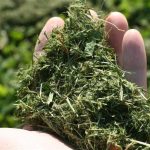
Farmers around the globe now feeling the pinch of higher fertilizer prices and more
Thursday, January 27, 2022 by Mary Villareal
http://www.products.news/2022-01-27-farmers-now-feeling-higher-fertilizer-prices.html

The high fertilizer costs are now weighing on farmers in the developing world, with many forced to cut back on production. This could signal global food prices to go even higher this year after hitting decade-highs in 2021. The problem lies in global energy costs, which have now flowed through into fertilizer prices. Moreover, fertilizer producers such as China, Turkey, Egypt and Russia have also curbed their exports, cutting supplies even further.
Whether it is South America’s avocado, corn and coffee farms, or Southeast Asia’s coconuts and palm oils, the high fertilizer prices are weighing in on farmers all over the globe, making it much costlier, forcing many farmers to cut back on production.
Rodrigo Fierro, a producer of avocados, tangerines and oranges in his 10-acre farm in central Colombia said that he has seen fertilizer prices double in recent months.
While farmers in the U.S. are also feeling the pinch, with some shifting their plans, the impact is expected to be worse in developing countries where smallholders have limited access to bank loans and can’t pay upfront for expensive fertilizer.
In sub-Saharan Africa, fertilizer demand could fall 30 percent in 2022, according to the global nonprofit organization International Fertilizer Development Center. This fall in demand could translate to 30 million metric tons less food produced, which is equivalent to the food needs of 100 million people.
In Europe, farmers prepare to spread fertilizers on fields after winter, with prices giving them little choice but to use less to pass on the cost down the food chain. However, Josef Schmidhuber, the deputy director of the United Nations Food and Agriculture Organization’s trade and markets division, said that lower fertilizer use will inevitably weigh on food production and quality. It can affect food availability, rural incomes and the livelihoods of the poor.
Farmers for staples like corn and wheat rarely experience fertilizer crises fueled by an energy crunch, export curbs and trade sanctions. Today, it costs much more to buy chemicals necessary for winter crops that are coming out of dormancy, and the added expenses could prompt lesser spring plantings, which could affect roughly a third of European grains. (Related: Higher fertilizer prices causing higher food prices around the globe.)
Europe, in particular, has been hit by fertilizer-plant cutbacks due to the soaring costs of natural gas that are used to run them. The nutrient prices remain at record highs even as pressure eased in the North Americas. If harvests continue to suffer, or if crop prices rise, Europe could still face a deficit of about nine percent of its annual nitrogen fertilizer needs in the first half of the year.
Higher fertilizer prices add to food costs
More and more households need to cut back on the quantity and quality of food they consume, as high fertilizer prices were adding to the costs of groceries and food supplies. In 2020, around 2.4 billion people lacked access to adequate food, up 320 million from the year before. Inflation also rose in nearly 80 percent of emerging market economies in the last year, with roughly a third seeing double-digit food inflation.
Tony Will, chief executive of leading nitrogen fertilizer manufacturer CF Industries Holdings Inc., which is based in Deerfield, Illinois, said that he expected lower fertilization levels this year to result in lower agricultural yields. The company only reopened one of their two U.K. plants that closed down in September due to high natural-gas prices and the low availability of truck drivers. However, their plants in North America are running at maximum capacity. (Related: Farmers are reducing how much food they produce due to surging fertilizer prices.)
With natural gas prices remaining high in Europe, industry experts believe that production is likely to be more constrained there, especially considering the shortages in parts of the developing world, which were amplified by trade restrictions in other major fertilizer exporters.
Other related stories:
Soaring fertilizer prices expected to make food inflation even worse
THE WORLD GOES HUNGRY: Fertilizer prices projected to reach near-record high in 2022
Food prices increase as fertilizer costs surge
As Food Prices Rise, Fertilizer Shortage Now Threatens World’s Farms
Coffee prices soar to 7-year high as supply woes hit top producers Brazil, Colombia and Vietnam
Watch the video below for more information about surging fertilizer prices:
This video is from the Liberty Thoughts channel on Brighteon.com.
Follow Harvest.news for more updates.
Sources include:
Tagged Under: Tags: agriculture, Collapse, farming, fertilizer, fertilizer costs, fertilizer shortage, food collapse, food inflation, food prices, food scarcity, food shortage, food supply, harvest
RECENT ARTICLES


Food shortages reached record high in April as inflation continues to skyrocket
By Ethan Huff

Supply chain on the brink of COLLAPSE as diesel price surge hits trucking industry hard

Contrary to what people believe, electric vehicles are not cheaper than gas-fueled vehicles

Why every American should care that diesel prices are surging across the country
By News Editors
COPYRIGHT © 2017 PRODUCTS NEWS


